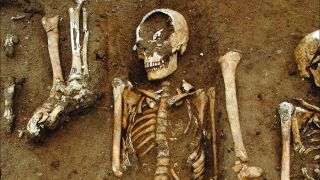
A close-up shows part of the mass grave at Thornton, where the deceased were carefully positioned and placed in an organized manner without any overlapping.
Archaeologists in England recently uncovered new details about a medieval mass burial of victims of bubonic plague.
When the so-called Black Death swept through northern Lincolnshire during the middle of the 14th century, sick and desperate people turned to the nearby Thornton Abbey’s hospital for care. So many people died there that the members of the abbey’s clergy were unable to prepare individual burials and instead had to bury the bodies in a so-called plague pit, Live Science previously reported.
But even though dozens of people were consigned together to a shallow mass grave over a period of just a few days, the remains were nonetheless treated with respect and received individual attention, according to a new study.
The pit held 48 men, women and children, and more than half of them were 17 years old or younger. Researchers paint a bleak picture of a community ravaged by a fast-spreading and deadly epidemic, leading to the first mass grave for plague victims in the U.K. to be discovered in a rural setting.
Scientists found the grave on the Thornton Abbey grounds in 2012; the fragile remains were excavated slowly and carefully over the next two years, and radiocarbon dating revealed that the people were buried in the 1300s.
Experts suspected that an epidemic was to blame, not only because of the number of bodies but also because of the wide range of victims’ ages. In medieval cemeteries, most of the graves typically are occupied by the very young and the very old, who were especially vulnerable to disease and fatal injury. “But what we’ve got is not that profile at all,” said lead study author Hugh Willmott , a senior lecturer of European historical archaeology at the University of Sheffield in the United Kingdom.
“We can tell from the proportion of individuals that everyone is being affected, and everyone is dying,” Willmott told Live Science. The timing of the deaths coincided with outbreaks of plague in England, and analysis of molar teeth from 16 individuals in the grave revealed DNA from — the bacteria responsible for plague.
Unusual location
Mass graves of plague victims were already known from burial sites in London, where the disease spread like wildfire between people who lived packed closely together, and who died by the tens of thousands between 1348 and 1350, the researchers reported. But until now, no mass graves for people killed by the Black Death have been identified in rural communities.
One explanation could be that even when many people died from the plague, life generally carried on “as normally as possible,” Willmott said.
“As people died, they were buried in a normal fashion — in individual graves in normal cemeteries. When you find a mass grave, it tells you that the system’s breaking down. That’s what we think happened here at Thornton,” he said.
Under ordinary circumstances, people in Lincolnshire would have been buried at the parish church, located about 1 mile (1.6 kilometers) or so from the abbey. But perhaps the disease had already killed the priest and the gravediggers, leaving the local community unable to cope with the rapidly accumulating dead, Willmott said.
“And so, what do they do? They turn to the canons [a type of clergy] who live in the abbey. And they pick up the problem and sort out burying the dead.”
In the grave, the bodies lay close together — but not overlapping — in eight rows arranged in a single layer, with young and old interspersed. The researchers found no personal effects, save a medieval belt buckle that likely fell into the grave accidentally, as it wasn’t directly associated with any of the bodies.
“The arrangement of the skeletons indicates that they were buried in a single event, rather than as individual interments,” the scientists reported.
However, even though the plague victims were buried as a group, each body nonetheless received special attention, and all were “prepared and deposited with great care,” the study authors wrote. Any wrappings around the skeletons had long since rotted away, but compression of shoulder bones in the skeletons suggested that the corpses were bound in shrouds before they were lowered into the pit.
Resilience after a pandemic
By the time the Black Death subsided in England in the early 1350s, half of the nation’s people had died, according to the study authors. And yet, society didn’t disintegrate and life went on, and within a century, population numbers had climbed back to where they were before the plague struck, said Willmott.
“The Black Death, or any pandemic, is a very personal tragedy for anyone who’s affected,” he said. However, perhaps this medieval outbreak also reveals a valuable lesson about human resilience and recovery in the aftermath of runaway infectious disease, Wilmott added.
“This devastating pandemic, while serious, didn’t collapse civilization. As a human race, we experienced this and moved on,” he said.
The findings were published online today (Feb. 18) in the journal Antiquity.
Sourse: www.livescience.com





